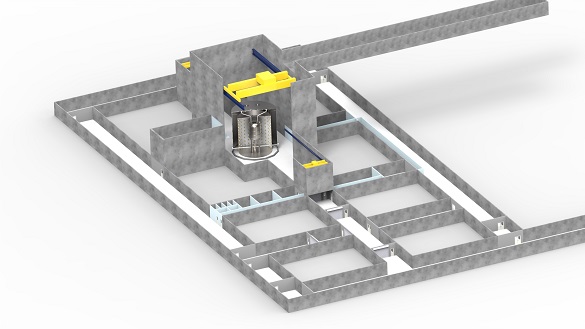
University of Liverpool researchers are part of a UK collaboration that has begun designing a new device to detect the elusive dark matter particles thought to make up more than 85% of the content of the Universe.
A preliminary award of £8 million from the UKRI Infrastructure Fund will support a consortium of UK universities, led by Imperial College London, to work with the Science and Technology Facilities Council (STFC) Boulby Underground Laboratory over the next three-and-a-half years.
As part of the world-leading Xenon Lux-Zeplin Darwin (XLZD) Consortium for dark matter research, the team will develop initial plans and design components for the world’s largest and most advanced dark matter detector. Once completed, this international experiment could be hosted at the UK’s deep underground science facility at Boulby mine in the North East of England.
A new frontier
One of the primary aims of the international XLZD Consortium is to build a definitive experiment to detect dark matter and explore its properties and origin.
The detector will consist of a large underground “thermos flask” containing up to 100T of liquid xenon, which scientists believe will react subtly with dark matter as it passes through the Earth. Tiny, but detectable, flashes of light will be generated as evidence of the presence of dark matter particles and recorded for scientists to analyse.
The experiment has the potential to change our understanding of physics in the same way that CERN’s Large Hadron Collider did when it detected the Higgs Boson particle in 2012. The XLZD observatory will explore the fundamental laws of physics but also acts as a telescope for the nature and composition of our universe, searching for dark matter particles and new neutrino physics.
Professor Sean Paling, Director and Senior Scientist at STFC’s Boulby Underground Laboratory said: “To discover, or even be able to rule out the existence of dark matter, will be an enormous leap for science and transform our understanding of the cosmos.
“We are now closer than ever to achieving this and as long as we can come together as an international community, invest in the right instruments, and remain focussed on our search, there are potential big breakthroughs just around the corner.
“The XLZD experiment is the clear next step for dark matter research and will also be an important instrument for understanding wider fundamental questions about the content of our universe. I’m delighted that Boulby, Imperial, and all contributing UK institutions are playing this key role in making it a reality.”
Professor Sergey Burdin, from the Department of Physics at the University of Liverpool, said: “This award, as well as the LZ results announced in August, demonstrates our strength and engagement in the highest quality science. A major opportunity to have a large-scale international experiment in the north of England certainly adds more excitement to this proposal.
“Here at Liverpool, we will lead the work on the Outer Detector which is based on our LZ expertise and strong synergy with the BUTTON@Boulby project led by Professor Jon Coleman.
“The XLZD@Boulby project represents a huge challenge including clean manufacturing underground and environmental sustainability of the experiment. This is also a great opportunity to expand the work on Dark Matter searches in Liverpool and create stronger links with theorists and engineers.”

Concept for the underground lab layout. Credit: Liam Cooper, STFC Technology Department
Laying the groundwork
The preliminary funding from the UKRI Infrastructure Fund will be instrumental in devising initial plans for how best to host and run the experiment in the near future and developing essential components required for constructing the detector.
UK project leader Professor Henrique Araújo, from Imperial College London, added: “Several underground laboratories around the world are bidding to host our experiment; this is fantastic “discovery science”, using the leading technology which we helped pioneer in the UK – and this development project is critical to position the UK to host. We must now show that this is viable!”
Although it remains to be decided exactly where the experiment will be located, this foundational work by UK universities and Boulby Underground Laboratory will be crucial in deciding how best to build the experiment for success. If the project is hosted at Boulby, this will be amongst the largest and most significant UK-based science projects in over 50 years, attracting international scientists to the North East region.
The project team comprises researchers from the institutions Birmingham University, Bristol University, Edinburgh University, Imperial College London, King’s College London, the University of Liverpool, Oxford University, Queen Mary, Royal Holloway, University of London, Sheffield University, Sussex University and teams from STFC’s Daresbury and Rutherford Appleton Laboratories.
This internationally collaborative effort highlights the UK’s strong commitment to advancing scientific research and its capability to contribute significantly to common worldwide scientific endeavours.